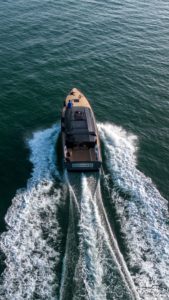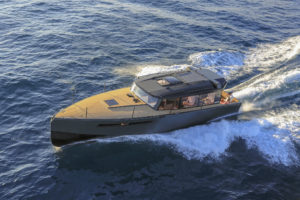JPK NOMAD 40
Motor Cruising
JPK launches its first motorboat ... and yet, it would be difficult to find more passionate about sailing boats than the JPK team!
The idea came to the shipyard to design an attractive motorboat for free dock to dock cruising with a focus on quality of life on board.
Of course, nothing can replace sailing... but the pleasure of being on the water and discovering new spaces outweighs everything else.
Our experience in building racing and fast cruising sailboats allows us to approach the world of motorboats from a completely different angle, both in terms of design and construction optimisation.
We have found that in the majority of cases, motorboats do not cover many miles and are limited to short trips because of the discomfort at sea (large and heavy boats that "slam") and the high fuel consumption.
Regarding the sailboat, the habitability is not optimal for the time spent in port (on average, yachts sail between 2 and 4 hours per day in summer cruising).
Many of us dream of having a modern, warm, open-air interior to communicate with a panoramic sea view and a deck flush just above the water.
Our project aims to appeal to both sailors and motor enthusiasts by combining a thin, high-performance hull with voluminous superstructures for maximum optimisation of the living space... all with a stylish design!
The JPK Nomad 40 is designed to be stable, seaworthy, performant and low on fuel consumption with a real pleasure of driving with a fine passage in the sea, unlike many boats.
Naval architect J. Valer
Designer : J-B. Dejeanty
-
LOA 11,98 m
-
BOA 3,70 m
-
Draft 0,78 m
-
Displacement 5 t
-
Headroom 1,98 m
-
Engine 110 à 150 cv
-
Cruising speed 12 kts
-
Max. speed 18 - 20 kts
-
Sleeping places 6 people
-
Beachable ✓
Our observation is that, in the majority of cases, motorboats do not travel many miles and are limited to short coastal trips because of their discomfort at sea (wide, heavy boats that 'bang') and high fuel consumption. Many of us dream of moving to a modern, welcoming interior, open to the outside world to communicate with a panoramic sea view and a deck flush with the water.
Jean-Pierre Kelbert
An attractive appearance, a high-performance hull, an improved habitability in a "tiny house" concept, a reduced fuel consumption and a great autonomy: the project aims to be sustainable and opens up a lot of space for freedom.
Jean-Baptiste Dejeanty, architect
Specifications
An attractive appearance, a high-performance hull, an improved habitability in a "tiny house" concept, a reduced fuel consumption and a great autonomy: the project aims to be sustainable and opens up a lot of space for freedom.
Called "Nomade", the boat is equipped with telescopic beaching legs integrated into the hull and easily retractable, so that it can be landed in all the corners that are usually inaccessible, particularly due to the tide.
The latest-generation atmospheric engine, from 110 to 150 hp, is silent and fuel-efficient, enabling the boat to reach an optimum cruising speed of 12 knots (18 knots top speed).
Hybrid electric drive possible for quiet journeys in protected areas.
In a "tiny house" spirit, the concept is designed around a living room with lots of windows, completely panoramic, with a long kitchen and a convertible U-shaped lounge/dining room. This unit opens onto the cockpit "terrace" on the same level, leading to a full width bathing platform.
At the front, two steps are all you need to descend below deck with a double owner's cabina WC/shower compartment and two bunk beds.
- Ouest France. Après les voiliers, le chantier JPK se met aussi au moteur
- Voile & Moteur. Grand Pavois 2023 : Le JPK Nomad 40 avec Moteur Boat
- Moteur Boat. Nomad 40 : Le savoir-faire de JPK transposé pour une croisière au moteur économe
- Available on newsstands : the full test of the JPK Nomad 40, in Moteur Boat: "Coasting revisited". Front page here.
Our latest news on JPK Nomad 40
Motor Cruising
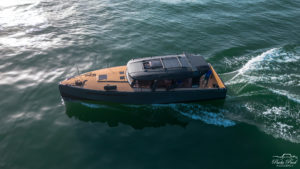
Nomad 40′ : Premières images !
Conditions météo idéales et présence de toutes les équipes du chantier pour fêter l’évènement car c’est un très long chemin parcouru avant d’en arriver là
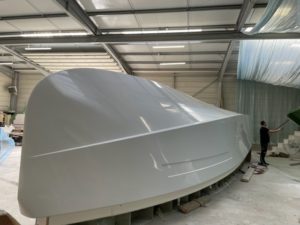

NOMAD 40: A milestone
Avec le démoulage du modèle de coque après la réalisation du moule, c’est clairement une étape charnière du projet qui vient d’être franchie. La préforme
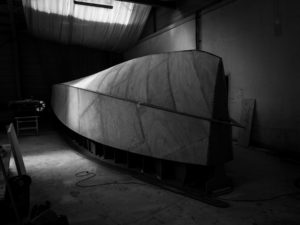

Construction of the JPK Nomad40 plug
The construction of JPK Composites' first motorboat, the JPK Nomad 40, has begun!

